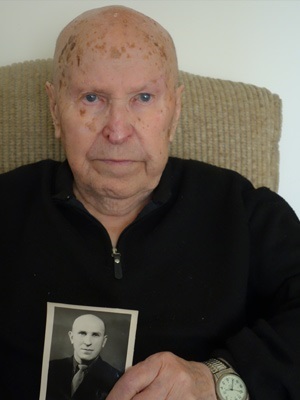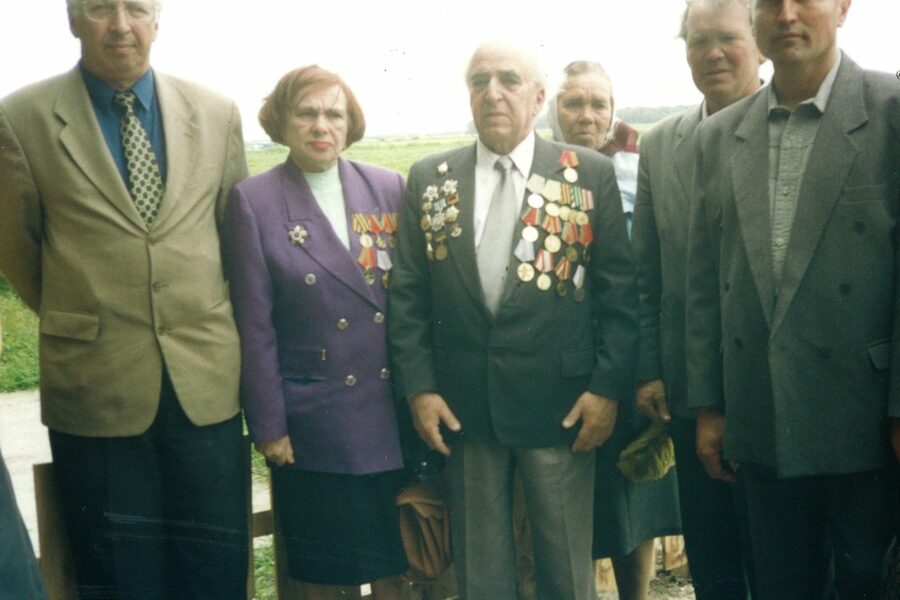Shika Kuperman lived in the Ukrainian town of Dunayevtsy, which was established as a shtetl during the sixteenth century and later was a hub of Jewish and Zionist literary scholars and collective farming. Shika was working as a blacksmith when World War II came to Dunayevtsy. Along with other townspeople, Shika was drafted into the Red Army. The Germans occupied Dunayevtsy in summer 1941. When the ghetto was created, Shika’s parents, siblings, and his wife, Anna, were forcibly moved there. During the three year occupation, the Nazis carried out public hangings and mass executions of the Jews. A witness interviewed by Yahad-In Unum (Father Patrick Desbois’ organization) described one of these executions: “The Germans gathered 700 Jews. They took them into the mine where the water rose until their knees. Afterwards, the entrance was exploded, and Jews were suffocated inside.” In fact, records show that on May 8, 1942, nearly 2,300 Jews were buried alive in those phosphate mines. Anna, Shika’s wife, survived; his parents, siblings, and their families died there.
Shika only learned about this tragedy when he returned to Dunayevtsy in search of his family. Unfortunately, his military battalion was surrounded by Nazis, and except for a few people (including Shika) who managed to get out, everyone was killed. Shika, who knew how to survive in the woods, was on his own for about a month, and then he was able to walk and crawl to Dunayevtsy to meet with his wife, Anna, in a ghetto.
The local Jews and the Jews from neighboring villages had been herded into a ghetto, an area fenced with barbed wire that stretched from the market square to the pond. Those leaving the ghetto were either going to work, or they soon would be dead. Food and water supplies were running low. Some local Ukrainians helped by passing water and food secretly through the barbed wire fence. Most Jews worked long days.
A detailed history of Dunayevtsy, including the years of the Holocaust, is found on the website History of Jewish Communities in Ukraine. A quotation from that section of the website offers a glimpse of the terrors experienced by the Jewish residents in the area:
During the construction of a garage for the German motor brigade on the site of the former Dunayevtsy regional printing house, the queue of laboring Jews—young and old—stretched from the nearby village of Sichentsy to Rozhok. Workers carried stones to Rozhok, while others returned to Sichentsy for another load. A pool with a fountain near the regional commissariat was built in same manner. Anyone who paused to catch a breath or stumbled or sat down was lashed or was shot on the spot. During the same period a water pipe that joined the commissariat and the commandant’s office was laid, the central square was paved with the marble slabs taken from the Jewish cemetery, and a waterwheel was constructed to power the pump connected to the fountain so that Gebietskommissar Eggers, exhausted after the daily executions, could enjoy his quiet evenings of meditation.
Bohuslav Vasilyevich Nadorozhny, a Dunayevtsy resident who was fourteen years old at the time and who worked at the mill, wrote in his memoir of the war: ‘I was a witness to how early in the morning three Jews, drenched with tar from head to foot, were coming back to the ghetto. They had to keep the fire under the tar barrel all night long, but they would keep falling asleep. In the morning, a German punished each of them by putting a ladle of boiling tar in their caps and forcing them to put them on their heads. Lack of food and water, hard labor, disease, beatings, humiliation—it all took away many lives.’
In stark contrast to this cruelty is the courage and humanity shown by a non-Jewish couple who saved the lives of Shika and Anna Kuperman. According to Yad Vashem’s website, in late October 1942, Shika and Anna appeared at the home of Iosif Gavelskiy and his wife, Anna, non-Jewish family friends who lived in a village near Dunayevtsy and asked them for shelter. They told the Gavelskiys how they had escaped when, yet another group of Jews was being taken to the death pits. Initially, Shika and his wife hid in the attic, but every night he went down and helped Gavelskiy dig a small hiding place in the barn. The Kupermans spent a total of eighteen months hidden there. Once a day either Gavelskiy or his wife brought the Kupermans a bucket with food and water and emptied their waste pail. No one else knew of their presence. On March 26, 1944, when the Red Army liberated Dunayevtsy, the Kupermans emerged from their hiding place and returned home. They later moved to the United States, but they maintained contact with their wartime rescuers. On March 5, 1998, Yad Vashem recognized Iosif Gavelskiy and Anna Gavelskaya as Righteous Among the Nations.
Shika Kuperman celebrated two milestones in spring 2018. Although he claimed to be 107 years old, he blew out candles on a cake which proclaimed his “official” birthday of 105 years old. The two-year discrepancy was not a reflection of the inevitable declining memory of a centenarian but rather a common symptom of a life disrupted by the Holocaust. Shika achieved the second milestone—a modicum of justice and recognition—more than seventy-five years after that life was forever disrupted and changed. After seven decades he finally received compensation from what is jarringly referred to as a “ghetto pension”—an elusive and complicated payment by the German government to recompense the “work” of Jews whom the Nazis forced into ghettos. Unfortunately, soon after reaching these two milestones Shika passed away.
Written by Yonit Hoffman, Never Heard, Never Forget: Vol. II, 2022






